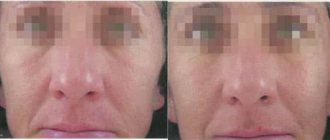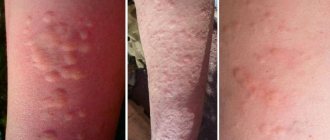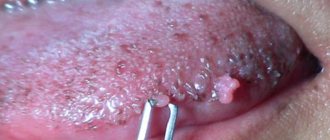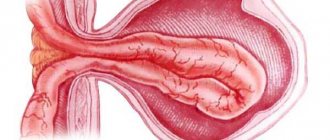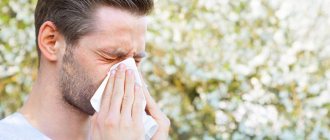Ichthyosis is a genetic disease in which the process of keratinization of the skin is disrupted. Hard scales, reminiscent of fish scales, form on it, and keratin with an altered structure accumulates in the epidermis. Most often, ichthyosis manifests itself in early childhood or even immediately after birth; less often, the disease is acquired.
Patients with this gene mutation suffer from impaired thermoregulation and their metabolism slows down. Due to the increased activity of enzymes in oxidative reactions in patients with ichthyosis, skin respiration processes are accelerated, the functioning of the thyroid gland, gonads and adrenal glands is disrupted. A person experiences a deficiency of cellular and humoral immunity. Dysfunction of the sweat glands is observed, which, against the background of improper absorption of vitamin A, leads to excessive keratinization of the skin. With ichthyosis, there is an excess of keratin with a disturbed structure. The shedding of dead skin cells occurs too slowly. Horny scales form on the skin, between which amino acid complexes accumulate, which contribute to hardening of the skin. Because of this, the formations are tightly linked to each other, and their separation is painful.
Patients with ichthyosis are characterized by brittle and dull hair, splitting nails, multiple caries, and patients often suffer from retinitis and conjunctivitis, and suffer from myopia.
Lamellar ichthyosis
Ichthyosis on the hands
Ichthyosis in the photo with a description of 7 pieces
Ichthyosis on the hands of an adult
Ichthyosis on the skin of an adult
Ichthyosis on the face of a child
Ichthyosis on the body of a child
Ichthyosis on the body in an adult
Ichthyosis on the face of a child
Ichthyosis on the knees
The disease is life-threatening. Children are born with low birth weight. Modern medicine has achieved success in saving the lives of little sufferers.
If previously an infant could not survive a systemic infection because thermoregulation was impaired, now medicine is able to save their lives.
What causes ichthyosis?
Ichthyosis is inherited and is a genetic disease. In medicine, there are several types of gene mutation:
- The autosomal recessive type is relevant for families where both parents have ichthyosis or are direct carriers of the abnormal gene. In this case, the child is born with this disease.
- Autosomal dominant occurs when one parent is the carrier of the gene. In this case, either a sick child is born, or a healthy one, but who is a carrier of the pathological gene and is able to pass it on to the future generation.
Types of ichthyosis
- Lamellar ichthyosis (lamellar, small scales form on the skin).
- Superficial (characterized by the presence of erosions, blisters on the dermis. Another name: epidermolytic).
- Acquired (formation of scales of different colors and sizes. They are located on the extensor surfaces of the limbs, cheeks, forehead).
- Simple (vulgar. Light gray scales appear on the skin, degenerating into brown “shields”. The skin is dry and flaky).
- Schleimann's ichthyosis (occurs in colloquial speech. But does not appear in the classification).
- Cameral ichthyosis (peeling, discoloration).
- Sebaceous ichthyosis (the secretion of the sebaceous glands dries out and is strongly secreted).
- Sebaceous ichthyosis of newborns (the body is covered with a crust of epithelial cells, hairs, and bristles).
- Follicular (appears at the exits of the hair follicles).
- Follicular superficial (appears in the form of convex dots).
- Serpentine (on the dermis there are dense horny scutes separated by grooves).
- Ichthyosis on the legs (pthenoid type of the disease, similar to lichen. Other types of disease affecting the body may occur). This photo shows what ichthyosis looks like on the legs:
- Ichthyosis of nails (thinned, split, brittle).
- Bullous ichthyosis (characterized by the appearance of blisters on the skin).
- Spiny (there are formations in the form of thorns).
Ichthyosis
- This is a hereditary skin disease that occurs as a dermatosis. The term “ichthyosis” comes from the Greek word ihtiosis (translated as fish) and combines a group of genetic skin pathologies that are accompanied by changes in the skin.
In such patients, the appearance of the skin resembles fish scales or the skin of reptiles. These changes are caused by genetic mutations that lead to impaired keratinization of the skin and the appearance of dry crusts and scales on them.
The disease may be present at birth (congenital ichthyosis), but usually first appears in early childhood and affects the entire subsequent life of a person. Acquired ichthyosis can occur as a result of health problems such as hormonal, inflammatory or malignant diseases.
Etiology of ichthyosis in children
The cause of the development of congenital ichthyosis is always gene mutations that are inherited. The factors that provoke such gene disorders have not yet been studied by geneticists. It is known that mutations lead to changes in many biochemical processes in the patient’s body, which are manifested by impaired keratinization of the skin. As a rule, signs of congenital ichthyosis are observed in a child immediately after birth, but sometimes they are noticed for the first time only in childhood.
Scientists have not yet fully studied all the mechanisms of development of this form of ichthyosis, but it has been established that gene mutation causes a malfunction in protein metabolism, and the accumulation of amino acids and lipids begins in the blood. The patient experiences a disruption of all metabolic processes, the activity of enzymes involved in the oxidative processes of skin respiration increases, and thermoregulation changes. Subsequently, insufficiency of cellular and humoral immunity develops, the activity of the thyroid gland, gonads and adrenal glands decreases, and a violation of the absorption of vitamins develops.
All these pathological changes lead to a slowdown in the rejection of the stratum corneum of the skin, and scales appear on the patient’s body, which in their appearance resemble the skin of reptiles or fish scales. Complexes of amino acids accumulate between the crusts and scales, which cause the keratinized areas of the skin to tightly stick together, and they are difficult to separate from the skin, causing pain in the patient.
The acquired form of ichthyosis is provoked by other diseases and often begins to appear in people over 20 years of age. This pathology can be caused by the following conditions:
· diseases of the digestive system;
· benign or malignant neoplasms;
· severe diseases: sarcoidosis, AIDS, leprosy, systemic lupus erythematosus, pellagra, hypothyroidism, etc.;
· chronic hypo- and vitamin deficiency (especially vitamin A);
· long-term use of certain medications: nicotinic acid, Butyrophenone, Triparanol, etc.
Classification of ichthyosis
At the moment there is no unified classification of ichthyosis. Pathology can be classified according to the following parameters:
· by genetic factor;
· by the nature of skin changes;
· according to the severity of the current.
Based on the genetic factor, the following forms of diseases are distinguished:
· caused by heredity ichthyosis;
· ichthyosis, manifested against the background of hereditary syndromes;
· ichthyosis-like conditions of an acquired nature, caused by diseases, medications or hypovitaminosis.
Based on the nature of skin changes, the following types of ichthyosis are distinguished:
· simple (or vulgar)
– develops in the first 2-3 years of life, manifested by severe dry skin, the appearance of grayish scales (there are such varieties of simple ichthyosis: abortive, white, shiny, bullous, lichenoid, serpentine, pityriasis, black, horny);
· spiny
– manifested by the appearance of horny formations in the form of needles or thorns;
·
lamellar
– a yellowish-brown film resembling collodion is observed on the newborn’s body;
· linear envelope
– ring-shaped areas of erythema appear on the body, which are surrounded by pinkish ridges with peeling in the form of plates (the outlines of such skin lesions may change over time);
· unilateral
– skin changes are located on one half of the body, the disease is accompanied by cystic kidney disease and multiple bone deformities;
· follicular (or Darier's disease)
- a rare disease that is accompanied by the appearance (approximately in the second decade of life) of horny nodular rashes and keratinization on seborrheic areas of the body (temple area, forehead, nasolabial folds, scalp, back, etc.), sometimes skin changes are observed in larger areas , areas of hyperkeratosis appear on the palms and soles, the pathology is often accompanied by mental retardation, endocrine disorders and cystic lesions of the lungs and bones;
· X-linked (recessive ichthyosis)
– can be observed from the moment the child is born, sometimes combined with Kallmann syndrome, fully manifested only in boys (girls are carriers of the mutated gene), skin changes are more extensive and pronounced (than with ordinary ichthyosis), cryptorchidism, hypogonadism, mental retardation can be observed , corneal opacities, skeletal abnormalities, microcephaly and other developmental anomalies;
· fetal ichthyosis (harlequin fetus)
– one of the most severe forms of the disease (children die immediately after birth or in the first weeks of life), develops at 4-5 months of fetal development, at birth there is a “shell” of very dry and thick skin on the child’s skin, severe deformation of the ears is observed, nose and eversion of the eyelids, limbs are deformed, signs of underdevelopment of internal organs can often be detected;
· epidermolytic
– one of the most severe forms of congenital ichthyosis, the skin of a newborn has a bright red color (as after a burn with boiling water), at the slightest touch the epidermis is torn off, on the feet and palms the skin is thick and white, by 3-4 years on the skin in the joint area Concentric ridges may form and the disease is often fatal.
Depending on the severity of the course, the following forms of ichthyosis are distinguished::
· severe – a newborn is born prematurely and dies in the first days of life;
· moderate – pathologies are compatible with life;
· late – the first manifestations of the disease appear in the first 2-3 months or 1-5 years of life.
Ichthyosis Clinic
Ordinary
or
vulgar ichthyosis
appears before the age of three, but is usually diagnosed before the third month of life. This is the most common form of ichthyosis, inherited in an autosomal dominant manner. First, the skin becomes dry and rough, then becomes covered with small whitish or gray-black scales tightly adjacent to each other. With ichthyosis, the area of the elbows, popliteal fossae, armpits and groin area are not affected.
Mucoid peeling appears on the palms, and the skin pattern becomes pronounced. The severity of ichthyosis depends on how deep the gene mutation is; an abortive course is possible, when the only manifestation of ichthyosis is dryness and slight flaking of the skin on the extensor surfaces.
With ichthyosis, hair, teeth and nails undergo dystrophic changes. Dry, brittle hair is typical, nails break off and split, and multiple caries develops. Quite often, ichthyosis is accompanied by eye damage - chronic conjunctivitis and retinitis. Patients with ichthyosis have a hereditary predisposition to myopia, which begins to manifest itself in childhood. Since immunity is reduced, allergic diseases and purulent infections are permanent. Later, disturbances in the functioning of internal organs occur, most often cardiovascular failure and liver disease.
Recessive ichthyosis
It occurs only in males, although it is inherited on the X chromosome and differs in that the cause of the disease is a defect in placental enzymes. Clinical manifestations appear in the second week of life, less often immediately after birth. The horny layers of the skin look like large dense scales of black-brown color and resemble scutes. The skin between the scales is covered with cracks, so it looks like the skin of a crocodile or snake. Children with recessive ichthyosis often have mental retardation, abnormalities in the skeletal structure, and epilepsy. Juvenile cataracts and hypogonadism occur in 10-12% of cases.
Congenital ichthyosis (fetal ichthyosis, Harlequin fetus)
develops in utero at 4-5 months of pregnancy. At birth, the baby's skin is covered with thick horny scutes of gray-black color. With congenital ichthyosis, the scales can reach up to 1 cm in thickness, the scales have different shapes, smooth or jagged, the skin between them is covered with grooves and cracks. Due to the dense, well-cohesive scales, the baby's mouth is either stretched or sharply narrowed so that the feeding tube barely fits. The ear openings are deformed and filled with horny scales, the eyelids are everted due to stretching. Almost all infants have skeletal anomalies - clubfoot, clubhandedness; many children with a congenital form of ichthyosis have interdigital bridges on the feet and palms, and sometimes missing nails. Pregnancy is often premature, and the rate of stillbirth is quite high. Since there are anomalies incompatible with life, most children with the congenital form of ichthyosis die in the first days of life.
Epidermolytic ichthyosis
is a form of congenital ichthyosis. The baby's skin is bright red, as if scalded by boiling water. Nikolsky's syndrome is positive, as with pemphigus of newborns - with a slight touch, rejection of the epidermal scales is observed. The skin on the palms and soles is white and significantly thickened. In some cases, with the epidermolytic form of ichthyosis, there may be hemorrhages in the skin and mucous membranes. This is an unfavorable sign; if hemorrhages occur, children most often die. With milder clinical manifestations of ichthyosis, the blisters become smaller over time, but throughout life the disease recurs in the form of outbreaks, and during a relapse of ichthyosis the temperature often rises to high levels. By the fourth year of life, horny layers appear in certain areas of the body in the form of thick dirty gray scales, which are localized mainly in places of natural skin folds.
There are often defects in the nervous, endocrine and other body systems; many children with congenital ichthyosis are later diagnosed with mental retardation and spastic paralysis, which is caused by the accumulation of phytanic acid in the tissues. Polyneuropathy, anemia, and infantilism complicate the course of ichthyosis. The mortality rate is very high due to associated complications and associated diseases.
Diagnosis of ichthyosis.
In most cases, diagnosing ichthyosis is not difficult. To carry it out, it is enough for a dermatologist to examine the patient and perform a histological examination
skin sample.
If congenital forms of ichthyosis or Harlequin ichthyosis are suspected, a pregnant woman is advised to undergo tests of amniotic fluid and a fetal skin sample (this is performed at 19-21 weeks of pregnancy). If the diagnosis of “Harlequin fetus” is confirmed, termination of pregnancy is indicated.
Treatment of ichthyosis.
Genetic forms of ichthyosis cannot be completely cured. Treatment of all forms of ichthyosis is carried out by a dermatologist. The need for hospitalization of the patient is determined by the severity of the clinical case.
Vitamins of group A, E, B, vitamin C and nicotinic acid are prescribed in high doses in long, multiple courses. Drugs that have a lipotropic effect soften the scales. These are preparations containing lipamide and vitamin U. To stimulate the immune system, blood plasma transfusions, gamma globulin, preparations containing iron and calcium, as well as aloe extract are indicated. If there are lesions of the thyroid gland with the development of hypothyroidism, then thyroidine is indicated; if there is hypofunction of the pancreas, insulin is indicated.
In severe cases and with congenital ichthyosis, hormone therapy is immediately prescribed ,
if there is eversion of the eyelids, then an oil solution of retinol is instilled into the eyes. After normalization of the condition, the dose of hormonal drugs is slowly reduced until completely discontinued.
During the period of remission, blood tests are performed periodically
, to monitor the patient’s general condition and prevent the development of complications. Nursing mothers are advised to take all the same vitamins as children with ichthyosis.
Local therapy
consists of taking general baths with a solution of potassium permanganate and lubricating the skin with baby cream with the addition of vitamin A. Adult patients with ichthyosis are shown salt and starch, general or local baths, depending on the location of the process. Vitamin A, sodium chloride and urea are added to the water.
UV irradiation in suberythemal areas
doses, Thalassotherapy and heliotherapy, resorts with sulfide and carbon dioxide baths stimulates metabolic processes in the dermis. Silt and peat muds are recommended already at the stage of resolving the relapse of ichthyosis and as a preventive measure.
Aromatic retinoids
Due to the fact that they restore the functioning of dermal cells and normalize metabolic processes, they have recently become widespread in the treatment of ichthyosis.
The treatment plan for ichthyosis is drawn up for each patient individually and depends on the form and severity of the disease. In addition to complex general and local therapy, such patients and their families are advised to work with a psychologist, since this disease is always associated with a violation of psychological balance.
Forecast and prevention of ichthyosis
The prognosis of ichthyosis in most cases is unfavorable, because even with a mild course of this disease, the patient often develops systemic pathologies, and the progression of metabolic disorders leads to the development of complications.
The only way to prevent hereditary forms of ichthyosis is to plan pregnancy with mandatory determination of the degree of risk of having a child with this pathology. Couples in which this pathology is observed in one of the parents are recommended to refuse to have their own children, IVF services using donor material (eggs or sperm) or adoption. If fetal abnormalities are detected already during pregnancy, a woman may be recommended to have an artificial abortion.
List of used literature
1) Differential diagnosis of skin diseases, ed. B.A. Berenbein and A.A. Studnitsyna, p. 479, M., 2001; Pototsky I.I. Ichthyosis, Kyiv, 2008, bibliogr.
2) Kryazheva S.S., Vedrova I.N. and Eletsky A.Yu. Clinical and genetic features of various forms of ichthyosis, Vestn, derm, i ven., No. 9, p. 17, 1987;
3) K u k l i n V. T., G a lch e n k o L. I. and L o m b e n k o Yu. N. Suvorova K. N. and Antonev A. A. Hereditary dermatoses , M., 1997,
Symptoms of ichthyosis
The result of the disease is a change in the structure of the skin. Due to malfunction of the cell, due to the loss of memory of a mutating gene (or the presence of another memory in it), the stratum corneum does not line up as it should.
The skin and its areas are covered with formations in the form of scales. The disease can be hereditary or acquired. Characteristic signs of ichthyosis include:
- dry dermis;
- peeling;
- presence of scales;
- the presence of spines, plates on the stratum corneum of gray, brown color;
- flour-like formations;
- thickening of the skin;
- film covering the body in newborns (disappears over time);
- nail damage;
- turned out mouth;
- brittle, dry hair;
- multiple caries;
- myopia;
- thermoregulation is impaired.
Why does the disease develop?
The pathology is hereditary, and the main cause of ichthyosis is a mutation of certain groups of genes, which is transmitted to children from parents. In rare cases, the disease is acquired and becomes a consequence of a lack of vitamins, a manifestation of certain blood diseases, etc.
Patients have a disturbance in the metabolism of proteins and amino acids, the activity of oxidative enzymes in the epidermis increases, and the concentration of immunoglobulins decreases. The etiology and pathogenesis are still not well understood, but many researchers note the important role of vitamin A deficiency and the function of certain glands - the thyroid and adrenal glands.
In patients with a genetic form of ichthyosis, metabolic processes, as a rule, slow down, thermoregulation is disrupted, and sweat glands do not work well. High levels of enzymes lead to a significant increase in skin respiration. Cellular and humoral immunity is often reduced. Hyperkeratosis is often accompanied by endocrine diseases, diseases of the adrenal glands and reproductive system, and eye diseases. Patients often experience increased brittleness of hair and nails, and teeth are easily affected by caries.
The skin contains an excessive amount of structurally altered keratin. Due to the slowing of metabolic processes, old skin cells are not shed quickly enough, which leads to the formation of hard scales on the surface of the skin. Amino acid complexes accumulate between the layers of skin cells, accelerating the process of hardening and keratinization, as well as holding the scales together.
Treatment of ichthyosis
What is ichthyosis and how to treat it? Science has not yet found a way to treat skin ichthyosis that can lead to complete healing.
But modern medicine can prolong the life of those suffering from severe illness and improve their well-being. A group of doctors works with patients. The medical team includes:
- Dermatologist (basic courses of treatment).
- Family doctor, therapist, pediatrician (comprehensive treatment aimed at improving immunity).
- Psychologist (relieving stress, depressive states, getting rid of complexes, pressures inherent in patients).
- Otorhinolaryngologist (observes the condition of hearing and eardrums).
- Dentist (treats teeth).
The group may include those specialists whose help is required in the fight against the underlying disease and complications. Patients receive complexes of therapeutic measures aimed at alleviating the condition of patients with skin ichthyosis.
Negative impact of the disease on the patient
Ichthyosis causes not only external harm, but also affects the processes and functions of the body:
- the functionality of the pancreas and adrenal glands is inhibited;
- the functioning of the gonads is disrupted;
- there is a lack of cellular immunity;
- vitamin A is not absorbed;
- spastic paralysis;
- oligophrenia;
- the functionality of the glands responsible for sweat production decreases;
- pain when trying to “clean” the skin;
- cardiac dysfunction in the body;
- mental retardation;
- Possible death.
Mortality among children with congenital ichthyosis is highest.
Drugs for the treatment of ichthyosis
This includes ointments, creams, and gels that are applied to the skin. They help clear areas of scales and ease the course of the disease.
The skin needs to be moisturized and softened, as cracks form on it, which can become infected. Therefore, antimicrobial and antifungal drugs are chosen.
Also, moisturizing creams, shower gels with a therapeutic effect, and ointments with urea are selected.
Hydrotherapy (hydrotherapy)
How else can you treat ichthyosis of the skin? Baths have a good effect. Typically used:
- saline;
- starch;
- with a solution of potassium parchment;
- marine;
- carbonic.
Applications using peat and silt mud give good results. As a result of treatment, metabolism in the body and in the skin itself improves.
Vitamin therapy
Patients are offered vitamin and mineral complexes. They are available in capsule form. Therapy is aimed at increasing immunity. The drugs act as general strengthening agents.
Long-term oral use of vitamin A, its analogues (retinoids) B, C, E, PP leads to softening of scales, cleansing of the skin, and increasing its elasticity. The drug is prescribed by a doctor in a small dosage, since side effects are possible.
Diet therapy (proper nutrition)
The patient’s diet should include foods rich in vitamins A, B, E, C. They will relieve hypovitaminosis, which is one of the causes of ichthyosis. The menu should include:
- Dairy products.
- Cheese.
- Meat.
- Yellow, red fruits, vegetables.
- Seafood.
- Porridge.
- Dried fruits.
Vegetables and fruits should not oversaturate the menu. This may cause allergies.
Heliotherapy
Treatment with the sun and its infrared radiation is indicated for those suffering from the disease. For this purpose, there are special devices that collect the sun's rays into a beam. He is sent to sore spots.
Thalassotherapy
Treatment with a marine climate involves not only sea bathing and walks in the air. The use of algae and seafood will enrich the patient’s menu and saturate the body with many useful substances.
Wrapping in therapeutic mud is also indicated for this diagnosis.
Climatotherapy refers to alternative methods of treatment. This method was proposed to the world by naturopaths. Treatment not only relieves symptoms, but also strengthens the psyche, elevates mood, and improves condition.
The cell is built by DNA chains. When a mutation occurs in the gene, the skin is left without a healthy stratum corneum, since the gene does not remember how it is built.
But he remembers how scales are built, that is, the skin of the inhabitants of the underwater world. This is how the skin is built for an underwater, amphibious inhabitant.
Types of pathology
More than 90% of patients develop ichthyosis vulgaris, a disease that first appears in the second or third month of life. Depending on the nature of the skin lesion, the following clinical forms are distinguished:
- xeroderma, or abortive form, is the mildest variant of the disease, in which the skin becomes dry and rough, but there are no scaly layers;
- a simple shape with small scales, thin at the edges and with a dense center, which cover the entire body up to the scalp;
- shiny shape with transparent scales located in the form of a mosaic mainly on the legs;
- white form with white or slightly yellowish scales, similar in appearance to asbestos fibers;
- serpentine in shape with rough keratinizations of brown, brown or gray color, reminiscent of snake scales.
Much less common is the lamellar form of the disease (collodion fetus), fetal (Harlequin fetus), linear, etc. Some of them are incompatible with life - for example, fetal ichthyosis develops in the second trimester of intrauterine development, and the child dies in the first days of life or is born already dead.
Treatment of ichthyosis with folk remedies
At home, herbs are used to treat ichthyosis. Therapy is aimed at relieving symptoms and improving well-being:
- Infusions help relieve itching and pain. They do lotions and rubdowns. Suitable raw materials are: motherwort, nettle, oats, rowan (berries), plantain, ivy.
- An ointment is prepared from pine resin, beeswax, celandine, chalk, St. John's wort oil, butter, and propolis.
- Collections are prepared from tansy, motherwort, horsetail, plantain, and wheatgrass. Apply orally, drink in courses of 30 days.
- Herbs from the collection can be combined with vegetable and olive oil and smeared on the affected areas.
How else can you treat skin ichthyosis at home? You can do herbal, salt baths, rinses with borax.
Prevention of ichthyosis in children
Consultation with a geneticist can help future parents. The test will show whether any of them is a carrier of the mutating gene and what kind of offspring they will have. If a woman is pregnant, doctors can diagnose the baby's disease while it is still in the womb, starting from the 16th week of pregnancy.
Specialists do a biopsy of fetal skin scraping, but the procedure is not safe. If the mother knows that the child is already seriously ill, the decision remains with her. There are no other preventive measures against the pathology.
Is it possible to cure ichthyosis of the skin?
Unfortunately, scientists have not yet fully understood the pathological processes that occur with this disease. It is incurable. There are a number of methods to alleviate the course of the disease.
Is it possible to cure mild ichthyosis? This is possible if the disease is acquired, not advanced, and treatment began immediately.
Only in very small areas of the stratum corneum can mealy, dry, brown formations remain.
Treatment of ichthyosis has many methods in its arsenal.
Clinical manifestations
The main symptom of ichthyosis - characteristic hard, scaly formations on dry skin - appears already in the first year of life, much less often - over the next few years. The child's skin becomes rough, and transparent, whitish or grayish scales appear on it, adjacent to each other. Only the elbow bends, the hollows under the knees and axillary areas, as well as the groin area remain clean. The palms and feet are peeling, and the skin pattern is clearly visible on them. In the mildest cases, the disease manifests itself only as slight peeling and dry skin.
Currently, there are more than fifty clinical and morphological forms of the disease, but in all cases the following manifestations are present:
- the stratum corneum of the epidermis is thickened, scaly formations and keratinization zones form on it;
- the skin is dry and flaky, the sebaceous glands practically do not work;
- the nail plates peel or break, in some cases they are deformed and resemble bird claws, peeling off from the soft tissues;
- the skin pattern becomes deeper and more expressive;
- There are rashes of different shapes and colors.
Skin ichthyosis usually worsens with the onset of cold weather. In warm weather, remission usually occurs. During puberty in adolescents, painful symptoms decrease, only to return in adulthood.

